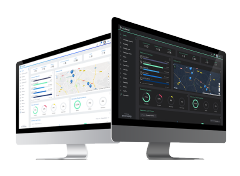
Electric airplanes: the solution to aviation pollution?
Electric vehicle | Sustainability | Environment | PollutionElectric airplane is the sustainable alternative to reduce the environmental impact of aviation: air pollution & greenhouse gas emissions.
One of the first decisions we make when it comes to travelling is the way we are going to travel. In the case of travelling to another country, almost without thinking about it, we choose the plane.
But have you ever stopped to think about the environmental impact of aviation and its consequences? We invite you to calculate the carbon footprint of your flight to find out how much CO2 it emits.
Aircraft pollution
The greenhouse gases generated by aviation that contribute to global warming and increased levels of air pollution are:
Carbon dioxide (CO2): due to the combustion of paraffin.
Nitrogen oxide (NOx): encompasses two different gases (nitric oxide or NO and nitrogen oxide or NO2) that are released at high altitude with a strong warming potential.
Ozone (O3): a potent greenhouse gas created through the high-altitude release of NOx.
Particulate matter: such as soot, sulphates, sulphur oxides, carbon monoxide, tetraethyl lead, hydroxyls and hydrocarbons, among others.
Aviation represents 2% of global greenhouse gas emissions according to ICAO, the International Civil Aviation Organisation.
Surely you're thinking... "Only 2%? That's nothing!" At first glance, it may seem like an insignificant figure, but in fact it is quite the opposite! According to Air Transport Action Group, aircraft produced 859 million tonnes of CO2 in 2017. That means that just 2% translates into millions and millions of tonnes of CO2.
So, yes, there are activities that pollute much more than aviation, but the real problem is that aviation activity does not stop, quite the contrary, reaching an increase of 128.9% compared to 1990! Emissions are increasing every year due to the exponential increase in traffic, both passenger, commercial and freight flights.
In 25 years, air passengers in the European Union have grown from 360 million to 1,106 million - which is a worrying increase. In fact, it is estimated that, if we continue at this growth rate:
By 2050 aircraft emissions will be 7-10 times higher (compared to 1990 levels)
By 2040, the number of air passengers will total 8.2 billion
Aviation pollution in numbers
Before providing you with representative data, we invite you to try the EcoPassenger calculator, which allows you to compare the emissions of CO2, particulate matter, nitrogen oxides, non-metallic hydrocarbons and energy resource consumption from planes, cars and trains.
We have done the test and for the same journey from Madrid to London:
The train would consume 52.4 kg of CO2
The fuel car would consume 157.6 kg of CO2
The aircraft would consume 265.2 kg of CO2
Saying this, some of the figures that we can highlight are:
In the United States, aviation emits 11% of the total CO2 emissions of the transport sector and accounts for almost half of the global CO2 emissions of this sector.
80% of air transport emissions are due to large passenger flights with distances greater than 1,500 km.
According to the Science Alert study, reducing the aircraft's flight altitude by about 600 metres would reduce the climate impact of its contrails by almost 60%. Some of these contrails can remain in the sky for hours, which increases the greenhouse effect and enhances climate change.
According to a study by the MIT (Massachusetts Institute of Technology), flights have a greater impact on air pollution than on climate change, causing up to 16,000 premature deaths per year. They claim that 95% of the impacts on air quality are closely linked to NOx emissions.
Short flights produce up to 150g/km of CO2 per passenger, while long flights produce around 110g/km of CO2 per passenger.
An economy class flight from London to New York emits about 0.67 tonnes of CO2 per passenger, according to ICAO. This is equivalent to 11% of the average annual emissions of someone in the UK, or the same as those caused in a year by someone living in Ghana, Africa.
Private jets emit up to four times more CO2 per person than an equivalent commercial flight.
Air operations (take-offs, landings, movements...) worsen air quality and emit multiple pollutants such as nitrogen oxides, ozone, carbon monoxide, unburned hydrocarbons and sulphur oxides.
In summary, we could broadly conclude that, on average, the carbon footprint of an air passenger is three times that of a car passenger.
But the figures are even more worrying if we consider commercial flights, as the demand for flights is increasing, driven by Asian countries such as China or technology giants such as Amazon or Aliexpress.
Measures to combat aircraft pollution
Fortunately, in 2016, CORSIA, the Carbon Offsetting and Reduction Scheme for International Aviation, was approved at the 39th ICAO General Assembly.
This plan, which is part of the European Green Deal, is included in the European Parliament's Proposal for a Regulation and aims to limit emissions and pollution from aviation through the Emissions Trading Scheme.
CORSIA establishes an emission offset system in which greenhouse gases produced by the aviation sector can be balanced by reducing or eliminating emissions in other sectors. However, the obligation to comply with these measures will not enter into force until 2027 for Member States.
Even so, more than 80 states have already expressed their voluntary participation in the first pilot phase of implementation, which starts in 2021.
With a view to complying with the Paris Agreement and the CORSIA plan, some airlines are therefore seeking to offset their emissions through:
Reforestation projects: such as KLM Royal Dutch Airlines, which donates one tree per ticket purchased for the reforestation of the Iberian Peninsula.
Use of biofuels that generate a lower carbon footprint, such as the Australian company QANTAS, which made the first flight with 10% biofuel obtained from mustard seeds, emitting 18,000 kg less CO2 (equivalent to 7% less emissions).
Reducing waste to achieve "zero waste" flights. The company QANTAS also wanted to stand out in this area by promoting its Bowebird project, in which it eliminates single-use plastics by replacing them with more sustainable alternatives - its goal is to eliminate 75% of its waste by 2021!
Well, it is up to us to assess whether it is completely necessary to travel by plane and to avoid as much as possible online purchases that are transported in an unsustainable way, opting for local shopping and a zero waste lifestyle.
Which is the real future of aviation: electric, hybrid or hydrogen airplanes?
The transport industry is clearly focused on developing and implementing CASE vehicles: Connected, Autonomous, Shared and Electric.
And some manufacturers in the aviation world don't want to be left behind, let's take a look at a few examples of sustainable aircrafts!
Airbus
Airbus has designed three prototypes of sustainable, zero-emission aircraft which, under the name "ZEROe", share the following characteristics:
Capacity between 100 and 200 passengers
Suitable for regional trips and up to transcontinental flights
Use liquid hydrogen (which would produce water vapour instead of CO2) in a fuel cell
Its aim is to make the first commercial flights in 2035 with these hydrogen aircrafts, in addition to the development of drones and VTOLs (Vertical Take-Off and Landing).
EasyJet
The company is proposing for 2030 the launch of Wright 1, an EasyJet electric-powered aircraft developed by Wright Electric, an American company founded in 2016 to develop electric aircrafts.
The aircraft will seat 186 passengers and have a power output of 1.5 MW. The British airline's long-term priority is to electrify all its flights.
Eviation
Alice is the electric airplane manufactured by the start-up Eviation, with a seating capacity of 9 and the aim of reaching a range of 1,000 km (equivalent to 650 miles), ideal for short distances and connecting nearby cities.
Terrafugia and Geely
Terrafugia, a US company of the Geely Group (current owner of Volvo), has already made its first successful flights of the TF-2A; a proposed 100% electric VTOL-type vertical take-off air taxi.
It has a capacity for 2 passengers, a speed of 180 km/h and a range of 100 km, ideal for city transport:
The company has also developed the TF-X, a plug-in hybrid flying car (two electric motors and a petrol engine), also for vertical take-off, with a capacity for 4 occupants and a range of up to 800 km.
Hyundai and Uber
Air taxis are getting closer and closer! That's why Hyundai and Uber don't want to be left behind and presented their new prototype at CES 2020: Hyundai S-A1. The 100% electric plane-taxi will have 5 occupants, will be able to reach 290 km/h and will have a range of 100 km.
VoltAero
VoltAero is another example of a hybrid aircraft that aims to include three 60 kW electric motors and a 370 hp fuel engine, whose function would be to charge the batteries of the electric motors. The aim is to have between 4 and 9 seats.
These are some of the most notable examples, but there are many more companies that are in development stages of new electric and/or hybrid prototypes, such as:
Archer Aviation: a start-up that has a new vertical take-off model under development, the eVTOL, with a four-person capacity, up to 240 km/h speed and a range of 100 km.
MIT: a company that is developing a new hybrid aircraft capable of reducing 95% of nitrogen oxide emissions, a gas that is harmful to human health.
HER0: 100% electric airplane designed by Joe Doucet that could be charged by solar or wind power and based on maximising aerodynamics and efficiency rather than speed.
And finally, we bring you the example of Airspeeder, an Australian project (from the company Alauda) that aims to become the world's first race of... flying electric cars! Yes, just like a Star Wars race!
💙🔌 How can Place to Plug help reducing aircraft pollution?
As Glenn Llewellyn (Airbus Vice President Zero Emission Aircraft) says, "the electric aircraft is not possible without the help of good infrastructure, government collaboration and the support of technology partners". Place to Plug, as a software provider, is committed to the electrification of transport and the promotion of a powerful charging infrastructure at airports.



Leave a comment
Comments ( 1 )
Thank you for sharing!! To explore further https://www.360iresearch.com/library/intelligence/aircraft-electric-motors